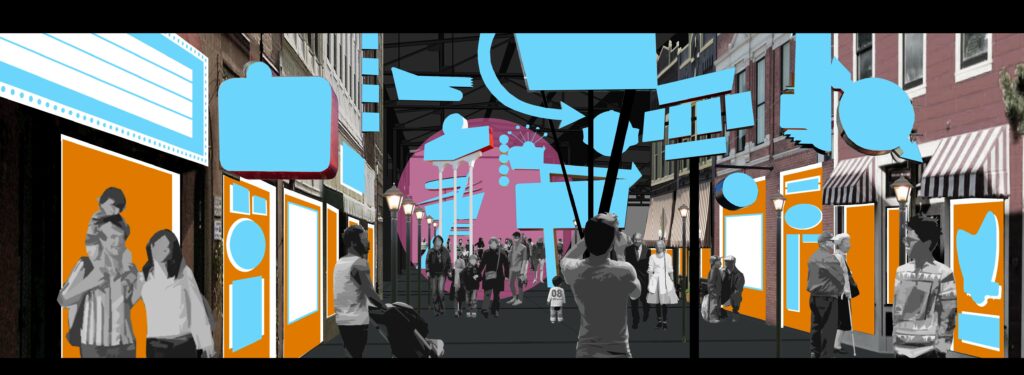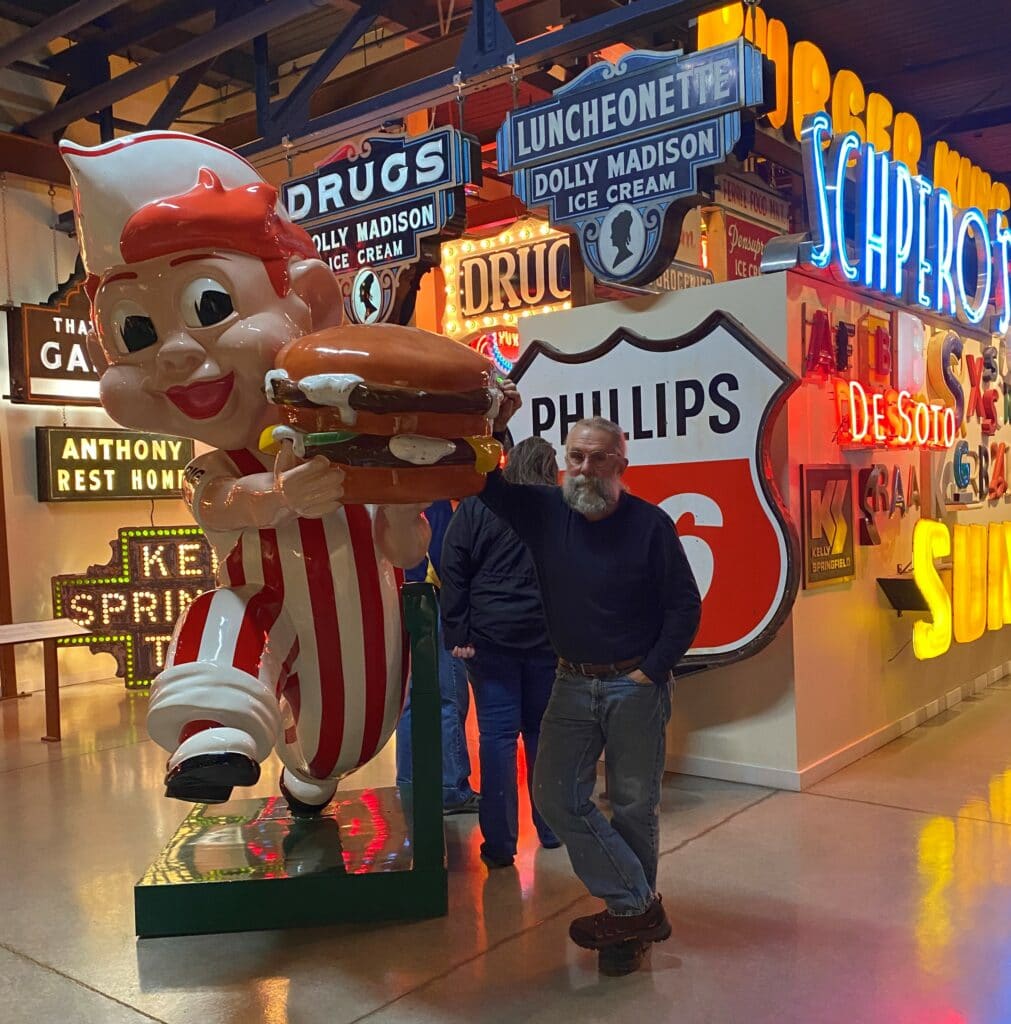The museum will extend exhibition space into the annex for a total of 40,000-square feet. Director Cynthia Kearns said, “By expanding into an undeveloped adjacent space, the American Sign Museum will continue to tell the story of American history through the conservation and preservation of historic signs.” The entire collection resides on one floor that’s easy to navigate, according to Erin Holland, manager of digital communications and engagement.

Designed by Platte Architecture +Design, construction of Phase 1 is complete. It includes staff offices, a conference room, collections area and a special events bar. The new library and resource center are part of Phase 1A and still in progress. They will support the research of the preservation, restoration, science, and design of signs. A new exterior along Monmouth Avenue will be completed by mid-2023.

Phase 2 of the expansion will complete the design concept and construction of the remaining museum expansion including an extension of the current Main Street exhibition space, an interior sign boneyard (sign junkyard), catering kitchen, storage area and a multi-use workshop. Anticipated completion date is spring 2024.
Architect Kurt Platte talked about several meetings with ASM staff to determine the direction the new museum wanted to go. The library is modeled after the Mercantile Library. Turnbull-Wahlert Construction Company provided the work for the project.
Swormstedt said, “I wanted to do this for fifteen years. It’s fun to see things in my head go real.” To him, sign making is an industrial craft as well as an art.
To expand required a capital campaign of $5.5 million to renovate the 20,000-square feet annex for additional trademark neon signs in addition to other historical signage. This was needed to augment the operating budget in 2022 of $1,094,000. The Swormstedt family, founder Tod Swormstedt, Tedd Swormstedt and Pam Kalkhoff, Wade Swormstedt and Wynne and Greg Winchell gave leadership gifts and will name the expansion the Swormstedt Family Wing.
In addition to major gifts from The Carol Ann and Ralph V. Haile, Jr. Foundation as well as Siri and Fred Oss of Gemini Sign Products, the state of Ohio’s 2023-2024 capital budget awarded $750,000 to the museum.
“With an anticipated opening in 2024, this campaign will broaden the museum’s programming and outreach offerings and increase areas to guarantee continued financial stability with earned income realized through facility rentals, admissions and merchandise,” said Kearns.
ASM board member for nine years and co-chair of the campaign Dick Duval was previously president of Cincinnati Preservation Society. As a result, he had some natural interest in sign history. “I am a hobby artist. That appealed to me. I learned so much from doing,” he said. There is an educational experience at ASM which he finds of interest. “I wish this was available when I was a kid,” Duval added.
“I have been on other boards. This board is fun,” said Duval. He fully supports the expansion as he believes the museum is one of the greatest educational things Cincinnati has to offer. When husbands come to Cincinnati for a seminar, the company often points their wives in the direction of the museum. Duval wants to see the museum appeal to a larger market.
Founder Tod Swormstedt started the museum as the National Signs of the Times in 1999 and renamed it the American Sign Museum in May 2005 when it was open to the public. The original building complex in Camp Washington was the century-old Oesterlein Machine Company – Fashion Frocks, Inc. Swormstedt now serves as a volunteer with Cynthia Kearns taking the reins as only the third director of the museum.
As founder of an unusual museum in the nation, Swormstedt preserves, archives and displays a collection of signs including Frisch’s Big Boy, Cincinnati Gardens, Turfway, Howard Johnson’s Ice Cream, Sky Vu Motel, and Philco. Prominent on the wall in the annex is Pops! in script which used to be a backdrop for Cincinnati Pops concerts. Long-time Cincinnati residents will remember these iconic restaurants, motels and stores.
Swormstedt travels out-of-state to retrieve signs. He found one in Chicago advertising Ward Bread, owned by the family who later made Wonder Bread and Hostess Twinkies. He plans to use a large triangular marquee to promote events in the renovated annex. He found it in 2021 from Ioka Theatre, now closed, in Exeter, New Hampshire.
Commercial signs include elegant gold-leaf glass signs of the early 1900s through pre-neon era of light bulb signs to neon’s heyday in the 1930s and 1940s and into the plastic era of the 1950s. There are also hand-carved wooden signs. It is the largest public museum dedicated to signs in the United States. The museum has over 3,800 signs and sign-related materials of which 300 are currently on exhibit displaying nearly 100 years. Over 200 signs have been restored since 2013.

The museum has not gone without notice nationwide. In 2023 the museum was nominated as one of the ten Best Readers’ Choice travel awards. In addition, an USA Today expert panel selected the museum as a contender for Best Pop Culture Museum. It placed tenth nationwide as one of two museums in Ohio.
TripAdvisor ranks the museum as number four out of 422 things to do in Cincinnati. In addition, museum staff greets over 50,000 visitors annually from all over the world. But, it is a positive addition to Camp Washington, a historically working-class residential and industrial community reinventing itself to attract artists, makers, small-business entrepreneurs and visitors.
“Programming at the American Sign Museum celebrates the rich tradition of the art and craft of sign-making. Through demonstrations and presentations, the museum hopes to encourage the next generation of builders, designers, artists, scientists, engineers and makers. This includes the upcoming Signs & Songs, the American Sign Museum’s most popular concert series, which affords fans of all genres – jazz, Americana, blues or rock – the opportunity to simply enjoy their favorite music while basking under the glow of neon lights with friends, new and old,” said Kearns.
There will be space to allow the museum to experiment with an artist-in-residence. Board members are interested in things that are participatory and push the limits of technology to interest visitors and younger guests.
In 2019 the Foundation for the Advancement of the Sign Industry ceased operation and transferred their repository of educational resources, technical knowledge, out-of-print publications and advocacy tools to the museum. According to Holland, these historic archives positioned the museum to become the national resource center for the conservation and history of signs.
The museum attracts more than 50,000 visitors from both inside and outside the region, according to Kearns. She said that the self-guided print tour and audio tour will be translated into six languages including German, Chinese, French, Spanish, Nepali and Arabic in addition to tours printed in Braille. It also hosts more than 150 public and private events annually.
Located at 1330 Monmouth Street in Camp Washington since 2012, it was originally housed in Essex Studios in Walnut Hills beginning in 2005. In spite of COVID, ASM maintained operations in the black by 2020.
The museum is open Wednesday – Saturday from 10 a.m. to 4 p.m. On Sunday it is open from 12 p.m. to 4 p.m. It is closed Monday and Tuesday. Admission rates are free for members, $15 for adults, $10 for seniors, $10 for youth and $10 for military/first responder.
For more information, visit the website at americansignmuseum.org.